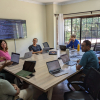The informal is everywhere – embrace it
In debates on security and justice programming in the last decade, it has repeatedly been confirmed that what we refer to as ‘informal’ or ‘non-state’ always has to be taken into account and always shape the art of the possible.
But what do we mean by ‘informal’? It is sometimes vaguely referred to as context or in relation to what is popularly considered the political economy, i.e., how and by whom resources are controlled and distributed. However, the informal comes in many different guises, which is why it is difficult to pin down.
In Somalia, for instance, clan identity and dynamics are considered part of the informal sphere. In Sierra Leone, chiefs and traditional leaders are relevant to draw out; gender-specific ‘secret societies’ that condition access to power and resources fit into a similar category of the informal, as do neo-patrimonial systems of resource distribution.
Donors like to blame such systems for the difficulties that these countries are facing – often referred to as corruption – and the limited success that a lot of security and justice programs have experienced in the course of implementation. However, there is very little evidence out there to suggest that external actors can alter informal structures in a fundamental way. A measure of success will be to find ways to work with them – at best – and if that is not possible, simply accept that they exist and understand that they will fundamentally shape programming.
Based on these brief considerations on what is meant by ‘informal’, three points are worth bearing in mind when it comes to the design and implementation of security and justice programming.
Build on what works. International development is shaped by the deep-seated assumption that if only internationally driven programming is designed correctly, tweaked in the right way and funded appropriately, there is a way to establish security institutions that are both democratic and abide by human rights (however we define them).
Rarely is it questioned whether proposals are in fact realistic, because realism is often equated with lack of ambition or weakness in programming. The problem is that structures of power and authority already exist in the contexts that such programs are designed for and implemented in. These structures will inevitably constrain what is possible.
This is why introducing entirely new types of institutions into rural Sierra Leone or urban Somalia that are alien to those contexts, is bound to fail. It seems like a commonsensical point, but the introduction of ‘ideal typical’ institutions, tweaked to fit a particular context, still occurs regularly in programming.
To have a chance of succeeding, programming must be built up around structures of authority that already exist; structures that are often referred to as informal, but are part and parcel of the contexts in which an intervention takes place.
Influencing informal structures is not a ‘local’ phenomenon. There is an underlying assumption that when we talk about informal structures of power, we mean local actors such as chiefs and clan leaders. In short, they are important to engage, because otherwise we – the international community – cannot access the population.
However, informal structures such as clan affiliations in Somalia directly impact national-level politics as well. Indeed, all positions of relevance in the Somali parliament and bureaucracy are distributed according to clan quotas. Other factors play a central role in how politics are played out and resources are distributed. For instance, many informed observers of Somalia will note that clan identity is overruled by economic interests and incentives. Yet, assuming that this somehow neutralizes clan identity as a structuring principle would be a mistake. And certainly, whatever is considered ‘the informal’ cannot be dealt with in isolation from political life in general.
Informality is politics. Following from the above, ‘the informal’ should be seen as something that always influences or more accurately shapes what is achievable. If we want to boil it down to one factor, it is the fight that always occurs, especially in fragile contexts, over resources.
Changing how security and justice are provided as public services is ultimately about making changes to the organization of particular sectors. Inevitably, some people will lose out in the process. They are at risk of losing power and status or access to resources. As a consequence they will often resist what is being offered through security and justice programming.
Recipient governments might agree to security and justice programming, because they assume that it will make the security sector more effective at making arrests or fighting. Yet, donor-driven programming is rarely a matter of efficiency. Therefore, tension rises when it becomes clear that programming, as it has developed in the 21st century, is driven by attempts to make security and justice sectors more democratically accountable, for instance.
What do these considerations mean for security and justice programming? They mean that those who design programming should not only understand the context in which they operate. In most cases we have an abundance of data and analyses that would be helpful in this regard. What is required is knowledge of how to design programming that properly takes into account how authority is distributed in a particular country, including at the local level.
The reason is that what we cannot simply separate, isolate and work on (or dismiss) what we often refer to as the ‘informal’. It is an integral part of any system of governance, and must therefore be understood as such and taken into account when donor agencies design and implement security and justice programs.







Login or register for free to get all access to our network publications. Members can also connect and discuss with other members. Participate in our network.